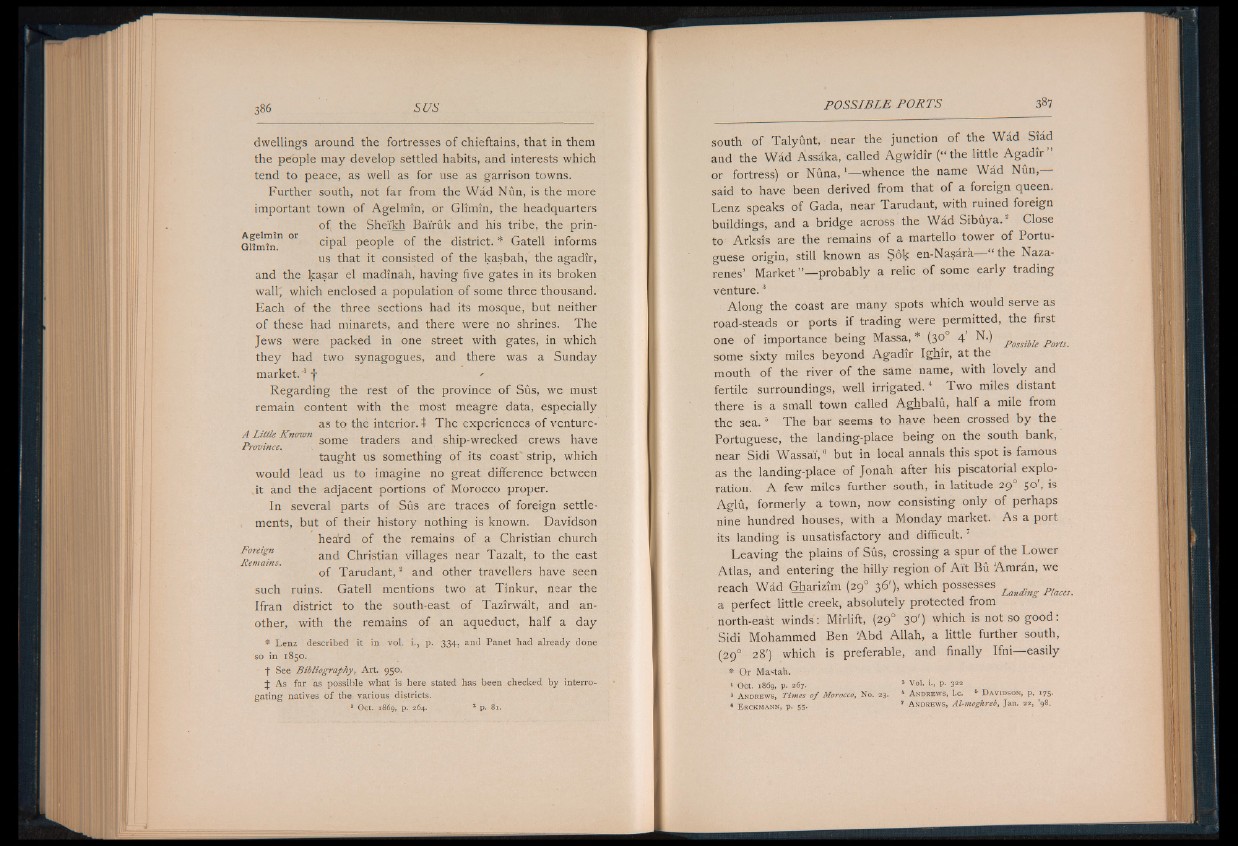
dwellings around the fortresses of chieftains, that in them
the people may develop settled habits, and interests which
tend to peace, as well as for use as garrison towns.
Further south, not far from the Wad Nun, is the more
important town of Agelmin, or Glimin, the headquarters
of the Sheikh Bai'ruk and his tribe, the prin-
Gnmtn” °r cipal people of the district. * Gatell informs
us that it consisted of the kasbah, the agadir,
and the kasar el madinah, having five gates in its broken
wall", which enclosed a population of some three thousand.
Each of the three sections had its mosque, but neither
of these had minarets, and there were no shrines. The
Jews were packed in one street with gates, in which
they had two synagogues, and there was a Sunday
market."1 j- '
Regarding the rest of the province of Sus, we must
remain content with the most meagre data, especially
as to the interior, t The experiences of venture-
A Little Known some tracjers anci ship-wrecked crews have
Province. ■ A
taught us something of its coast' strip, which
would lead us to imagine no great difference between
.it and the adjacent portions of Morocco proper.
In several parts of Sus are traces of foreign settlements,
but of their history nothing is known. Davidson
heaVd of the remains of a Christian church
Foreign and Christian villages near Tazalt, to the east
Remains. .
of Tarudant,2 and other travellers have seen
such ruins. Gatell mentions two at Tinkur, near the
Ifran district to the south-east of Tazirwalt, and another,
with the remains of an aqueduct, half a day
* Lenz described it in vol. i., p. 334, and Panet had already done
so in 1850.
t See Bibliography, Art. 950.
J As far as possible what is here stated has been checked by interrogating
natives of the various districts.
1 O c t . 1869, p. 264. 2 p. 81.
south of Talyunt, near the junction of the Wad Siad
and the Wad Assaka, called Agwidir (“ the little A g ad ir ”
or fortress) or Nuna,!— whence the name Wad Nun,—
said to have been derived from that of a foreign queen.
Lenz speaks of Gada, near Tarudant, with ruined foreign
buildings, and a bridge across the Wad Sibuya.2 Close
to Arksis are the remains of a inartello tower of Portuguese
origin, still known as Sok en-Nasara— “ the Naza-
renes’ Market”— probably a relic of some early trading
venture. 3
Along the coast are many spots which would serve as
road-steads or ports if trading were permitted, the first
one of importance being Massa, * (30° 4' N-) PossMe Pgrts
some sixty miles beyond Agadir Ighir, at the
mouth of the river of the same name, with lovely and
fertile surroundings, well irrigated.4 Two miles distant
there is a small town called Aghbalu, half a mile from
the s e a .3 The bar seems to have been crossed by the
Portuguese, the landing-place being on the south bank,
near Sidi Wassai,6 but in local annals this spot is famous
as the landing-place of Jonah after his piscatorial exploration.
A few miles further south, in latitude 290 50', is
Aglu, formerly a town, now consisting only of perhaps
nine hundred houses, with a Monday market. As a port
its landing is unsatisfactory and difficult.'
Leaving the plains of Sus, crossing a spur of the Lower
Atlas, and entering the hilly region of A it Bu Amran, we
reach Wad Gharizlm (290 36'), which possesses
a perfect little creek, absolutely protected from
north-east winds: Mirlift, (290 30') which is not so good:
Sidi Mohammed Ben Abd Allah, a little further south,
(29° 28') which is preferable, and finally Ifni— easily
* Or Ma^tah.
1 O c t . 1869, p . 267. 2 V o l. i., p. 322
3 A n d r e w s , Times o f Morocco, N o . 23. * A n d r e w s , I.e. 5 D a v id s o n , p . 175.
e E r c km a n n , p . 55. 7 A n d r e w s , Al-moghreb, J an . 22, ’98.